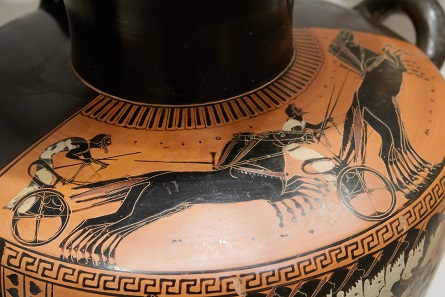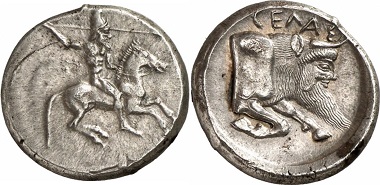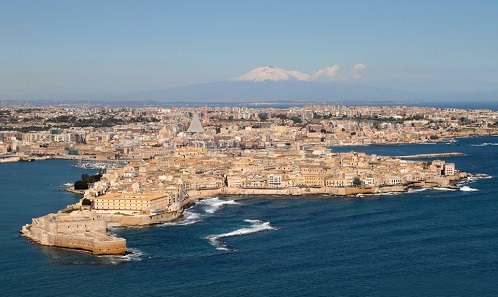translated by Annika Backe
In the previous two parts of the Sicilian Mosaic we looked at how the colonization of the Mediterranean island worked. Taking the coinage of Messana and Dankle as an example, we saw that the coin imageries of mother and daughter city were often similar, and that conquests were mirrored on coins as well. Conquests are at the heart of this part. Some movement enters into the history of Sicily. The tyrant of Gela starts his conquering expedition.
Stasis – all kinds of disunion within a city, from the internal fight of the nobility to class struggle and civil war – is a leitmotif of Greek history. Although the emigrants who arrived at Sicily had fled from the cramped conditions of their home, as soon as the initial problems were solved and the vital necessities seemed to be secured, however, the old leitmotif reared its head again. Some energetic figures turned the civic discord to their advantage and set themselves up as tyrant and leader of the community.
The chariot races in Olympia were famous and constituted a popular subject, as evidenced by this hydria dating from around 510 BC. Photograph: Marie-Lan Nguyen / https://creativecommons.org/licenses/by/2.5/deed.de
The tyrannis of Gela
In 505 BC, Cleandros seized power in Gela. This Cleandros was a member of the local aristocracy. His father Pantares had been the first to win the chariot race in Olympia.
After the death of Cleandros, on whose reign we have virtually no extant sources, a short civil war followed after which Hippocrates assumed power as the brother of murdered Cleandros. Here we have arrived at a few main motifs that constantly recurred with the early tyrants.
Olympian victories: sign of being chosen by the gods
Most of the time it were members of the aristocracy who set themselves up as the head of the city, by means of a military coup and often supported by the dissatisfied lower social strata. They placed value on expressing that they were favored by the gods. What better way to prove it than to gain a god-given victory in one of the great Panhellenic games of the old home? This provides the backdrop for the Sicilian tyrants’ interest in Olympia and the other contests.
The rulers of the first generation tried to secure the power for their families and their descendants – within the civic political system, however, they continued to be a foreign body that was often eliminated by freedom-loving noble men through civil war and assassination.
The expansion of Gela
After seizing power, Hippocrates expanded his area of influence. He built fortresses in the surrounding uplands and expanded his army. He hired a large number of mercenary soldiers and placed an emphasis on a well-drilled cavalry.
Struck in slightly later times, the rider on this didrachm reflects the ideal image of the aristocrats of Gela, most of all the tyrants. Gela, didrachm, ca. 497/485-480/475 BC. Ex Gorny & Mosch Auction 169 (2008), 16.
It is not for nothing that the first didrachms of Gela, which started minting coins under Hippocrates, feature a warlike rider brandishing a spear. In rapid succession Gela took Naxos, Messina as well as Leontinoi, and Hippocrates appointed loyal vasal tyrants in these cities. The attempt to conquer Syracuse failed. However, thanks to a peace treaty negotiated by Corinth, as the mother city of Syracuse, in 492 BC, the tyrant was given Camarina. Still not war-weary at all, Hippocrates confronted the Sicels, only to lose his life during a battle against them.
View of Syracuse. In the foreground the Ortigia peninsula that was populated as early as ancient times, the Aetna in the background. Photograph: I Fratelli Angelo and Giorgio Bonomo / cc-by-2.0.
The rise of Gelon
In 491, after a short civil war in Gela’s sphere of control, the commander of his cavalry, Gelon, became his successor. Thanks to a revolution in Syracuse, he could make another try at conquering this city in 485 BC. The unpropertied people had joined forces with the native population. Much like the serfs in Medieval times, these lawless people without possessions cultivated the land of the noble men. During this riot, the Gamores, the aristocrats of Syracuse, were driven out of the city. They asked Gelon for help, which he granted willingly. He met no serious resistance when he led the expelled ones back to their city and appointed himself tyrant also of Syracuse. As starting point for a major power, Syracuse was much more suitable than slightly remote Gela. To further enhance the strength of his power base, Gelon relocated half of Gela’s population to Syracuse.
This tetradrachm from Gela, dating to ca. 480/75 to 475/70 BC, features a victorious biga-charioteer on its obverse and a human-headed bull as the city’s landmark on the reverse. Ex Gorny & Mosch Auction 224 (2014), 48.
Gelon, the most powerful man in the West
With this conquest, Gelon became the most powerful man of Sicily, if not the entire European world: in 481, the Greeks are said to have sent a delegation to him, asking for his help against the Persians. Gelon apparently offered the following: he would bear the costs of the grain provisions for the entire army, and supply 200 ships, 20,000 infantry men, 5000 equestrians and slingers – provided he would be given the command of the entire Greek army in turn. Of course, the Greeks could not accept these conditions and refused to co-operate. Probably this was not exactly how everything actually happened but this episode nevertheless clearly illustrates what the mainland Greeks believed the tyrant in far-away Sicily to be capable of.
You will learn more about the coinage of Gela in the upcoming part of the Sicilian Mosaic.
The article was originally published in MünzenRevue 3/1997.
All parts of the series can be found in our archive.
If you are interested in Sicily, be sure not to miss the numismatic travel diary “Sicily in full bloom”! The whole series can also be found in our archive.









